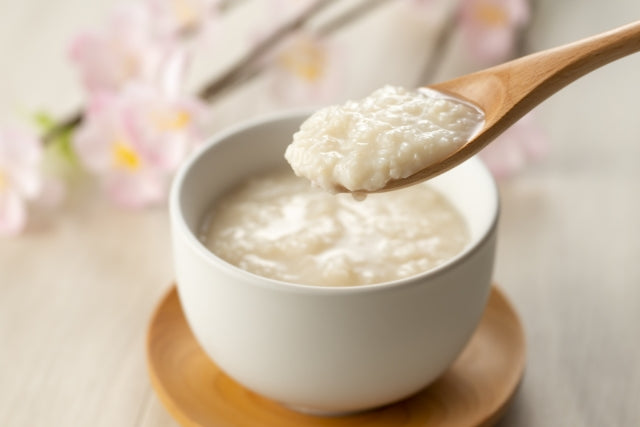Beautiful skin effect! The charm of "malted rice" that is essential for making miso

Hello, this is Yukimi from MISOVATION staff.
It's sudden, but have you ever eaten "shiokoji"?
Shio-koji is a versatile seasoning that has been attracting attention in recent years for its ability to bring out the umami of ingredients, but many people may not be familiar with it.
This shio-koji actually not only enhances the umami flavor, but when meat or fish is marinated in shio-koji, the protein is broken down into amino acids, resulting in a very soft finish.
I've been fascinated by shio-koji and have been making it by hand for the past few years, and it's surprisingly easy to make. Just buy "dried koji" from a supermarket or online, mix it with hot water and salt, and stir it with a spoon once a day for about a week!
If you always keep it in your refrigerator, you can enjoy it by adding a little seasoning to your dishes, or by moistening and softening ingredients that tend to dry out, such as chicken breast.
This time, we will introduce the charm of "koji", which is indispensable for seasonings such as miso and soy sauce that support Japanese cuisine.
|
table of contents The deep relationship between miso and koji |
The deep relationship between miso and koji
Miso can be categorized into various types according to ingredients, flavor, color, etc., but koji is essential to any miso.
Koji is rice, barley, soybeans, etc., in which microorganisms called aspergillus oryzae are propagated. In the case of miso, if rice koji is used, "rice miso" is used, and if barley koji is used, "barley miso", all soybeans are kojiized. Then it becomes "bean miso".
In 2006, the Brewing Society of Japan designated it as a "national fungus". The climate of Japan is suitable for living, and it has a history of supporting the food culture of Japan as a resident fungus that inhabits the natural world widely.
This koji plays two main roles in making miso.
・Produces an enzyme called protease to break down proteins ・Produces an enzyme called amylase to break down starch
The protease breaks down the soybean protein to bring out the unique umami flavor of the soybean, and the amylase breaks down the starch in the rice and barley to bring out the unique sweetness of the rice and barley.
Aspergillus oryzae brings out the umami and sweetness of soybeans, rice, and wheat. The relationship between koji and miso is very deep.
Nice skin effect too! The charm of Koji
It is said that the hands of toji (sake brewers) and koji craftsmen who handle koji on a daily basis have always been white and beautiful. From this phenomenon, it is thought that koji contains ingredients that are good for the skin, and as a result of research, a substance called "kojic acid" was discovered.
The melanin pigment that causes skin spots is activated by an enzyme called tyrosinase under the influence of ultraviolet rays, etc., and converts amino acid substances in human body cells into spots. "Kojic acid" has been found to have the effect of blocking the action of this tyrosinase, and in 1988, the then Ministry of Health and Welfare approved "kojic acid" as a whitening ingredient for the first time as a quasi-drug. It is used as a whitening ingredient in cosmetics.
In addition, it has been clarified that the ingredients in rice koji activate the synthesis of ceramides (*) in the skin and increase the amount of ceramides in the skin, thereby enhancing the barrier function of the skin. As a result, it is known that the water content of the skin is maintained and the skin is protected from dryness and rough skin.
(*) One of the important moisturizing factors that exists between the stratum corneum cells of the skin and keeps the skin moist.
I would like to aim for healthy and beautiful skin from the inside of my body by incorporating foods containing koji into my daily diet.
If you are concerned about your skin condition, why not choose a miso with a high koji content?
Let's enjoy various koji with MISOVATION
At MISOVATION, we use different kinds of miso from all over Japan every month, so you can enjoy rice koji, barley koji, soybean koji, and many other types of koji.
In the past, rare miso using natural koji mold has also appeared. In fact, in modern times, the natural koji mold has almost disappeared, and it is common to buy koji starter from a koji shop to make miso. world.
Please pay attention to what kind of koji is used together with monthly miso!
See you next time♪
References
・"Miso Encyclopedia" Atsumitsu Watanabe (Tokyodo Publishing Co., Ltd.)
・"Actually, we are alive thanks to bacteria" Hiroshi Konno (Wani Plus Co., Ltd.)
・Analysis of kojic acid biosynthetic pathway in koji moldja (jst.go.jp) Motoaki Sano ・Beauty effect of koji with the power of koji|R&D of Marukome (marukome.co.jp)

